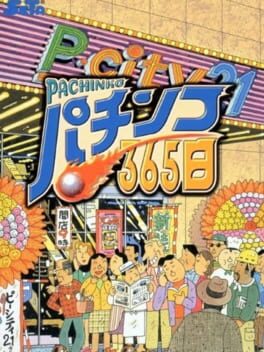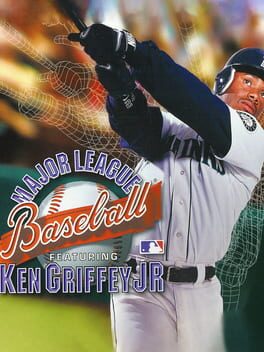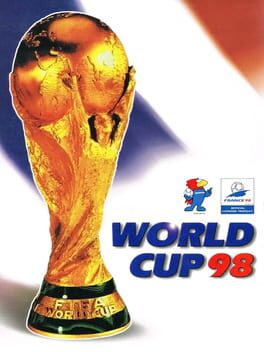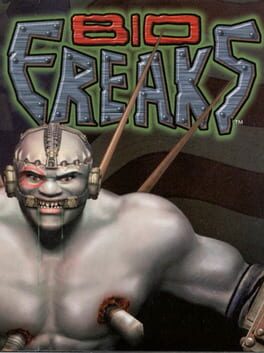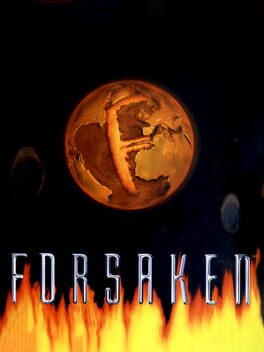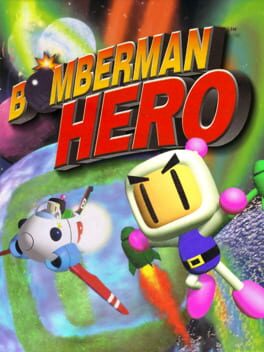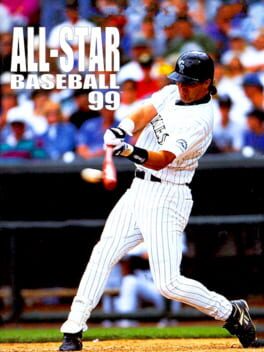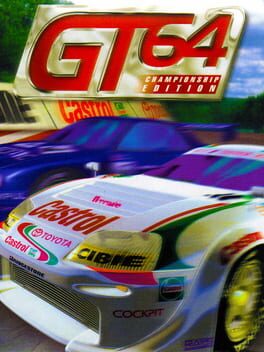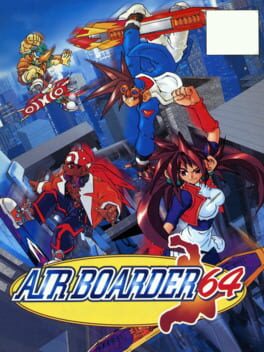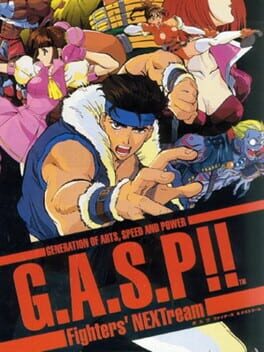Cube1701
1998
Another Pachinko game. While I still have zero interest in the Japanese hybrid of slot machines and 10p machines, this one at least seems competently made. You can properly walk around the three Pachinko parlours to find machines and they look alright. You can also talk to the guests, who have various things to say about Pachinko.
The pachinko is still just pachinko, but the a and b buttons now increase/decrease the ball release lever, actually giving you control over how the balls are fired. There are five machines, one of them being an “old style” one.
In this one, you manually launch the balls into the machine, instead of the standard autofire ones. It adds a bit of variety.
The goal of the game is to play over the course of one year (with a day being sped up) to try and earn as much money as you can.
The pachinko is still just pachinko, but the a and b buttons now increase/decrease the ball release lever, actually giving you control over how the balls are fired. There are five machines, one of them being an “old style” one.
In this one, you manually launch the balls into the machine, instead of the standard autofire ones. It adds a bit of variety.
The goal of the game is to play over the course of one year (with a day being sped up) to try and earn as much money as you can.
With this being published by Nintendo, you would hope for a fun and solid portrayal of Baseball, similar to how NBA Courtside did the same for Basketball. Unfortunately, while this does go for a more arcade-style format, it’s rather clunky and messy by comparison.
This features a similar system than most of the other N64 baseball games, and this seems to be the easiest to hit the ball – but still almost impossible to actually do anything with it, struggling to land a hit that doesn’t go straight to an opponent, while the CPU hit a home run first try.
One thing I do like is that the games seem snappier and go by much quicker, so you can get through a match in a decent time, but this is just an average baseball game.
This features a similar system than most of the other N64 baseball games, and this seems to be the easiest to hit the ball – but still almost impossible to actually do anything with it, struggling to land a hit that doesn’t go straight to an opponent, while the CPU hit a home run first try.
One thing I do like is that the games seem snappier and go by much quicker, so you can get through a match in a decent time, but this is just an average baseball game.
1998
World Cup 98 is simply FIFA Road to World Cup 98 with some minor gameplay changes and a ton of stuff removed. While the previous game had every official international team, plus teams from multiple leagues (such as the Premiership), this just has the teams that qualified for the world cup (plus 8 extras).
The gameplay has some minor tweaks that isn’t as noticeable and one of the fun parts of the previous game – the indoor 5-a-side – is also gone. This is just the previous game with fewer stuff.
Interestingly, the FIFA branding is missing (even though the World Cup is a FIFA tournament) – I wonder if they thought that not having the FIFA name would make people think that this is another competitor to try out.
The gameplay has some minor tweaks that isn’t as noticeable and one of the fun parts of the previous game – the indoor 5-a-side – is also gone. This is just the previous game with fewer stuff.
Interestingly, the FIFA branding is missing (even though the World Cup is a FIFA tournament) – I wonder if they thought that not having the FIFA name would make people think that this is another competitor to try out.
1998
I really had no idea that the N64 had so many people trying to claim the title of being the N64’s fighting game. In BioFREAKS, the concept is that in a dystopian future, people have been modified into grotesque monsters (although, predictably, the female characters aren’t modified as much). The only notable character to me was a fish monster, although he oddly throws up blood before and after matches.
A couple of things set BioFREAKS apart. First is the hover, where you can fly. This doesn’t seem that well integrated into the fighting and is mainly used to making distance, as this fighting game relies a lot on projectile attacks, which don’t even need special attacks to use. Levels are a 3D but not that interesting, although a couple do make use of the flying.
Do enough damage to an opponent and they may lose limbs and lose some of their attacks. I think this is supposed to look gruesome (as with the whole game), but it all comes across as laughably silly, unlike the gore in Mortal Kombat.
This isn’t bad, but it’s just another fighting game on the N64.
A couple of things set BioFREAKS apart. First is the hover, where you can fly. This doesn’t seem that well integrated into the fighting and is mainly used to making distance, as this fighting game relies a lot on projectile attacks, which don’t even need special attacks to use. Levels are a 3D but not that interesting, although a couple do make use of the flying.
Do enough damage to an opponent and they may lose limbs and lose some of their attacks. I think this is supposed to look gruesome (as with the whole game), but it all comes across as laughably silly, unlike the gore in Mortal Kombat.
This isn’t bad, but it’s just another fighting game on the N64.
This is an “improved” and updated version of ClayFighter 63⅓ featuring some gameplay changes and new characters. It was exclusive to Blockbusters, the small amount of copies being sold after the promotion ended, making it one of the rarest N64 games. That said, everything good about the game you see before the main menu: the game’s intro is a nice little song.
But the game is still incredibly slow and tedious. The main changes to gameplay are the removal of a bunch of special moves. Some of the new characters are slightly more inventive than the originals, but there’s still none that I wanted to actually choose.
This is just a small patch for a terrible game.
But the game is still incredibly slow and tedious. The main changes to gameplay are the removal of a bunch of special moves. Some of the new characters are slightly more inventive than the originals, but there’s still none that I wanted to actually choose.
This is just a small patch for a terrible game.
1998
When it comes to remastered versions of games, I give play around with the remaster and the N64 version a bit to compare feel and features. While Forsaken Remastered is a great version, it’s based on the PlayStation/PC version and while it contains the N64 exclusive levels, it lacks a few features and the exclusive levels are bonuses, so it felt a bit to different to play – so I stuck to the N64 version (if you just want to play the game, then definitely play the Remaster).
Forsaken is a spaceship combat game that takes place in cramped maze-like arenas. Naturally, this feels very disorientating, even though the controls (once you adjust them to your liking and get used to them) do a good job at allowing you to move in so many directions and there’s a lot of weapons to find and use.
The third person mode is exclusive to the N64 version and looks near with the see-through ships, but a lack of crosshairs makes it difficult to aim. It’s still a nice novelty, though. There’s a lot of levels, but unfortunately they all feel quite samey, and while enemies look different, they don’t feel that different to blow up.
That said, Forsaken 64 is a decent game, there’s a lot of levels and a good multiplayer. A bit of variety and some more open levels would be nice, though. There’s also a lot of impressive background lore and detail on the characters, none of which is really carried through to the game, which is just a case of completing the objectives and going to the next level.
Forsaken is a spaceship combat game that takes place in cramped maze-like arenas. Naturally, this feels very disorientating, even though the controls (once you adjust them to your liking and get used to them) do a good job at allowing you to move in so many directions and there’s a lot of weapons to find and use.
The third person mode is exclusive to the N64 version and looks near with the see-through ships, but a lack of crosshairs makes it difficult to aim. It’s still a nice novelty, though. There’s a lot of levels, but unfortunately they all feel quite samey, and while enemies look different, they don’t feel that different to blow up.
That said, Forsaken 64 is a decent game, there’s a lot of levels and a good multiplayer. A bit of variety and some more open levels would be nice, though. There’s also a lot of impressive background lore and detail on the characters, none of which is really carried through to the game, which is just a case of completing the objectives and going to the next level.
1998
Coming out a mere six months after the first Bomberman game on N64, this Bomberman game seems like it was developed as a separate take on Bomberman rather than a sequel to Bomberman 64 (it actually started out as a Bonk game). This focuses solely on platforming rather than the more puzzle-orientated Bomberman 64, but unfortunately doesn’t so much with it.
Bomberman Hero is made up of a lot of short, linear levels, ether played from side to side or up into the screen. You collect gems, kill enemies and try to get to the door. The main challenge is from the poor depth perception and rather naff jump, with the difficulty of the first level and final level being pretty much the same. Very few levels stand out, and the ones that do (one that adds a lot of fog and one on moving platforms) do so because they’re particularly bad.
There are a few types of vehicle levels, which all feel like slow and boring copies of Star Fox 64. Move into the screen, firing off torpedoes while avoiding enemies.
Bosses are a particular nuisance, not so much that their attacks are difficult to dodge, but rather because they have a lot of health and take ages to defeat – the last world before the ending being comprised of repeated boss sections before the final boss.
Like Bomberman 64, there is a hidden final bit of story, but the game is far to dull to hunt for all the collectibles required to do so – and it’s just more of the same, really dull gameplay. It’s nowhere near as tedious as Bobmerman 64, it’s just a really boring and average platformer.
Incidentally, despite Bomberman being legendary for multiplayer, Bobmerman Hero has no multiplayer whatsoever.
Bomberman Hero is made up of a lot of short, linear levels, ether played from side to side or up into the screen. You collect gems, kill enemies and try to get to the door. The main challenge is from the poor depth perception and rather naff jump, with the difficulty of the first level and final level being pretty much the same. Very few levels stand out, and the ones that do (one that adds a lot of fog and one on moving platforms) do so because they’re particularly bad.
There are a few types of vehicle levels, which all feel like slow and boring copies of Star Fox 64. Move into the screen, firing off torpedoes while avoiding enemies.
Bosses are a particular nuisance, not so much that their attacks are difficult to dodge, but rather because they have a lot of health and take ages to defeat – the last world before the ending being comprised of repeated boss sections before the final boss.
Like Bomberman 64, there is a hidden final bit of story, but the game is far to dull to hunt for all the collectibles required to do so – and it’s just more of the same, really dull gameplay. It’s nowhere near as tedious as Bobmerman 64, it’s just a really boring and average platformer.
Incidentally, despite Bomberman being legendary for multiplayer, Bobmerman Hero has no multiplayer whatsoever.
Licensed sports games aren’t what you expect to be published by Nintendo, but here we are with NBA Courtside, a licensed basketball game and one that does a really good job with the sport. The graphics are particularly good on the N64, with some really nice reflections on the court.
At first, it seemed like a very back and forth game like other baseball games, with you and your opponent taking turns to score, but I eventually learnt how to properly tackle and defend (players you aren’t directly controlling move to sensible positions) and was able to go on the offensive and win some matches. Controls are fluid with a lot of options to adjust to your liking.
NBA Courtside is a very solid basketball game, one that is enjoyable for non-Basketball fans and probably great for those who are into the sport.
At first, it seemed like a very back and forth game like other baseball games, with you and your opponent taking turns to score, but I eventually learnt how to properly tackle and defend (players you aren’t directly controlling move to sensible positions) and was able to go on the offensive and win some matches. Controls are fluid with a lot of options to adjust to your liking.
NBA Courtside is a very solid basketball game, one that is enjoyable for non-Basketball fans and probably great for those who are into the sport.
The N64’s first baseball game that was actually released in America (and Europe). This follows similar control schemes to most of the Japanese baseball games, aiming the bat with the stick. One notable thing is that this is entirely in 3D, and doesn’t switch to a different style when the fielders are chasing the ball.
Like Power Pros 5, it also has an indicator to show where the ball is heading towards, but this is initially confusing as it moves as the ball curves, and I did manage to hit the ball a few times and even get a home run. The computer still feels like they’re far too skilled, especially when catching balls, though.
There’s a nifty cheat that allows for playing in an alien stadium (which deforms players to look alien-like) but there aren’t a lot of modes. This seems like a decent baseball game, but that’s coming from someone who has yet to win a baseball match in a video game.
Like Power Pros 5, it also has an indicator to show where the ball is heading towards, but this is initially confusing as it moves as the ball curves, and I did manage to hit the ball a few times and even get a home run. The computer still feels like they’re far too skilled, especially when catching balls, though.
There’s a nifty cheat that allows for playing in an alien stadium (which deforms players to look alien-like) but there aren’t a lot of modes. This seems like a decent baseball game, but that’s coming from someone who has yet to win a baseball match in a video game.
Racing games that go for “realism” really don’t age as well as sillier and more arcade-style racing games, and GT 64 when it came out was already just a cheap cash-in to make itself look like Gran Turismo on the N64. Due to this, GT 64 is a truly horrid experience without a single redeeming feature.
Before each race, you need to qualify for starting position. The default is a 3 lap time trial which sounded horrible, so I selected “special stage”. This is a 1 lap time trial, but with a warm up lap before it. The racing itself is very stiff and janky, and the CPU racers feel more like obstacles than rivals. There’s also no music, with the only sound a really horrible engine noise – I ended up muting the game.
You race across three tracks, and then race across slightly different versions of those three tracks – with the difference between “shot and long” feeling less unique than the different routes in their previous game, Multi-Racing Championship. Then you can play the three tracks two more times in mirror mode.
Cruis’n USA had some mild bouts of enjoyment, this is just pure tedium all the time and the worst racer on the N64 so far.
Before each race, you need to qualify for starting position. The default is a 3 lap time trial which sounded horrible, so I selected “special stage”. This is a 1 lap time trial, but with a warm up lap before it. The racing itself is very stiff and janky, and the CPU racers feel more like obstacles than rivals. There’s also no music, with the only sound a really horrible engine noise – I ended up muting the game.
You race across three tracks, and then race across slightly different versions of those three tracks – with the difference between “shot and long” feeling less unique than the different routes in their previous game, Multi-Racing Championship. Then you can play the three tracks two more times in mirror mode.
Cruis’n USA had some mild bouts of enjoyment, this is just pure tedium all the time and the worst racer on the N64 so far.
1997
Some arcade games are great for playing for hours, making home console ports good ways to play. Others are fun for 10 minute bursts and you see how soulless they are if you sit down for much longer. Rampage is one of the latter games.
You take control of one of three monsters (not-King Kong, not-Godzilla and a wolf monster) and smash buildings and eat people. Being a monster is fun to start with, but the fun only lasts for a few minutes as you smash up the same few types of buildings again and again. There’s zero variety – once you’ve played the first level, you’ve pretty much experienced the whole game.
It all feels a bit clunky, too, smashing buildings feels a bit awkward as you have to jump onto them to start the process, movement just isn’t fluid and there aren’t many ways to take out a building. Everything already felt dated when it came out on the N64, and time hasn’t helped it out.
That said, Rampage World Tour is an accurate port of the arcade game, which itself is an accurate update of the original. If you really, really wanted to play Rampage at home, this provided that experience – it just didn’t do anything else.
You take control of one of three monsters (not-King Kong, not-Godzilla and a wolf monster) and smash buildings and eat people. Being a monster is fun to start with, but the fun only lasts for a few minutes as you smash up the same few types of buildings again and again. There’s zero variety – once you’ve played the first level, you’ve pretty much experienced the whole game.
It all feels a bit clunky, too, smashing buildings feels a bit awkward as you have to jump onto them to start the process, movement just isn’t fluid and there aren’t many ways to take out a building. Everything already felt dated when it came out on the N64, and time hasn’t helped it out.
That said, Rampage World Tour is an accurate port of the arcade game, which itself is an accurate update of the original. If you really, really wanted to play Rampage at home, this provided that experience – it just didn’t do anything else.
1998
Air Boarder 64 is a trick-based skateboarding-style games, but on hoverboards. The fascinating thing about Air Border is that this came out before Tony Hawk’s Pro Skater. The unfortunate thing is that the developers of Air Border never seemed to figure out what the player is supposed to do in a game like this, instead opting for a bunch of random modes.
You have a trick mode (spoiled somewhat because you have to hit gates in a certain time), a time trial, coin collection and free play. It all feels like the developers were testing different things, but none of them really feel like a completed feature, seeming a bit disjointed. The five levels also feel like they’re each from a completely different game, with zero cohesion in theme or level design.
You have the starting skate park, a forest level, a bit of a city during winter, a few islands connected by a massive bridge and one where you’re tiny in a house. Like the modes, these also feel like they were testing random ideas and couldn’t work out a direction for the game. None of them take advantage of the fact that you can fly up walls, either.
Even though it feels more like a lost prototype than a final game, I can’t help but find this game fascinating, and the core movement and tricks are enjoyable. It’s not a good game but, even with its complete lack of direction, it’s not terrible, either.
You have a trick mode (spoiled somewhat because you have to hit gates in a certain time), a time trial, coin collection and free play. It all feels like the developers were testing different things, but none of them really feel like a completed feature, seeming a bit disjointed. The five levels also feel like they’re each from a completely different game, with zero cohesion in theme or level design.
You have the starting skate park, a forest level, a bit of a city during winter, a few islands connected by a massive bridge and one where you’re tiny in a house. Like the modes, these also feel like they were testing random ideas and couldn’t work out a direction for the game. None of them take advantage of the fact that you can fly up walls, either.
Even though it feels more like a lost prototype than a final game, I can’t help but find this game fascinating, and the core movement and tricks are enjoyable. It’s not a good game but, even with its complete lack of direction, it’s not terrible, either.
Battle Puzzle Balls is a collection of three games, two puzzlers and then a bonus minigame. It features a cast of random characters including a “magical girl” that might be a vampire, a mad scientist, a rockstar, a baby and an axolotl.
The first game is a variation on Puyo Puyo. In this version, a group of three will make them disappear (instead of four) and the “bad blocks” sent from your opponent can be turned into regular balls. Unfortunately, there are no colour options and I couldn’t tell apart the green and yellow – these also lack the slight shape variation from Puyo Puyo.
The second game has the same linking and chain rules as the previous, but instead of balls coming from the top of the screen, you have a pair of wings that can pick up one of the balls, swapping it with another. The green is a darker colour in this game so I could tell the difference, so I was able to do fairly well at it.
The final mode is a very basic bowling game. A cursor swings up and down the screen and you press A at the right time to bowl. It’s like a rather naff java version of bowling.
This is mainly just a less fun version of Puyo Puyo.
The first game is a variation on Puyo Puyo. In this version, a group of three will make them disappear (instead of four) and the “bad blocks” sent from your opponent can be turned into regular balls. Unfortunately, there are no colour options and I couldn’t tell apart the green and yellow – these also lack the slight shape variation from Puyo Puyo.
The second game has the same linking and chain rules as the previous, but instead of balls coming from the top of the screen, you have a pair of wings that can pick up one of the balls, swapping it with another. The green is a darker colour in this game so I could tell the difference, so I was able to do fairly well at it.
The final mode is a very basic bowling game. A cursor swings up and down the screen and you press A at the right time to bowl. It’s like a rather naff java version of bowling.
This is mainly just a less fun version of Puyo Puyo.
One simple change makes this a huge improvement over Power Pros 4: when the ball is pitched, a target appears on screen for you to aim at. It still needs incredibly quick reflexes, but you now have a chance of hitting the ball. The computer is still completely perfect, though, catching pretty much everything you hit while they always hit a large gap between your players.
Another new feature is the scenario mode, which gives you a bunch of in-progress games and you need to try and win from that position. It’s very similar to the scenario mode from International Superstar Soccer.
The RPG mode also returns, but there’s just an immense amount of text involved in it, so it’s difficult to keep track of what is going on.
Interestingly, there’s still no N64 baseball game that has released in the USA by the time this came out.
Another new feature is the scenario mode, which gives you a bunch of in-progress games and you need to try and win from that position. It’s very similar to the scenario mode from International Superstar Soccer.
The RPG mode also returns, but there’s just an immense amount of text involved in it, so it’s difficult to keep track of what is going on.
Interestingly, there’s still no N64 baseball game that has released in the USA by the time this came out.
What does Generation of Arts, Speed and Power mean? It means someone really wanted the game’s initials to spell out “GASP”. As for “Fighters’ NEXTreme”? I have absolutely no idea – probably why this was renamed to the extremely generic “Deadly Arts” in America. This is another fighting game on the N64, one that has one interesting feature, but is unfortunately not that fun to play.
GASP is all about combos, but the input window makes it difficult to pull any off, so I found a couple of simple moves and spammed then. The default timer is very short, so KOs are unlikely and if time runs out, you get judged on multiple categories, so the person with less health may win. The characters are all completely uninteresting and just look like prototype versions from other fighting games.
The one interesting thing is “create-a-fighter”, although options are extremely limited. You then train by fighting others and, if you win, you get to learn one of their moves, although with how much of a faff they are to perform, it doesn’t mean much.
This joins the rather large list of bland fighters on the N64.
GASP is all about combos, but the input window makes it difficult to pull any off, so I found a couple of simple moves and spammed then. The default timer is very short, so KOs are unlikely and if time runs out, you get judged on multiple categories, so the person with less health may win. The characters are all completely uninteresting and just look like prototype versions from other fighting games.
The one interesting thing is “create-a-fighter”, although options are extremely limited. You then train by fighting others and, if you win, you get to learn one of their moves, although with how much of a faff they are to perform, it doesn’t mean much.
This joins the rather large list of bland fighters on the N64.
